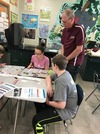
Lesson Length: 1-2 hoursGrade Level: 6-8Students will explore the carbon emission impacts of different lifestyle choices. The activity is grounded in engineering design thinking as it relates to a family's carbon footprint and options to shift that footprint to make change (trade offs). Students will understand carbon impacts, work in teams (families) to negotiate lifestyle adjustments, and brainstorm opportunities for engineered improvements to decrease carbon emissions.This material is based upon work supported by the National Science Foundation under Grant No. 1657263. Any opinions, findings, and conclusions or recommendations expressed in this material are those of the author(s) and do not necessarily reflect the views of the National Science Foundation.
- Subject:
- CTE
- Career Connections
- Earth Resources
- Living Systems and Processes
- STEM/STEAM
- Science
- Scientific and Engineering Practices
- Technology Education
- Trade and Industrial
- Material Type:
- Activity/Lab
- Game
- Interactive
- Lesson
- Lesson Plan
- Visual Media
- Author:
- VT PEERS
- Date Added:
- 11/17/2020